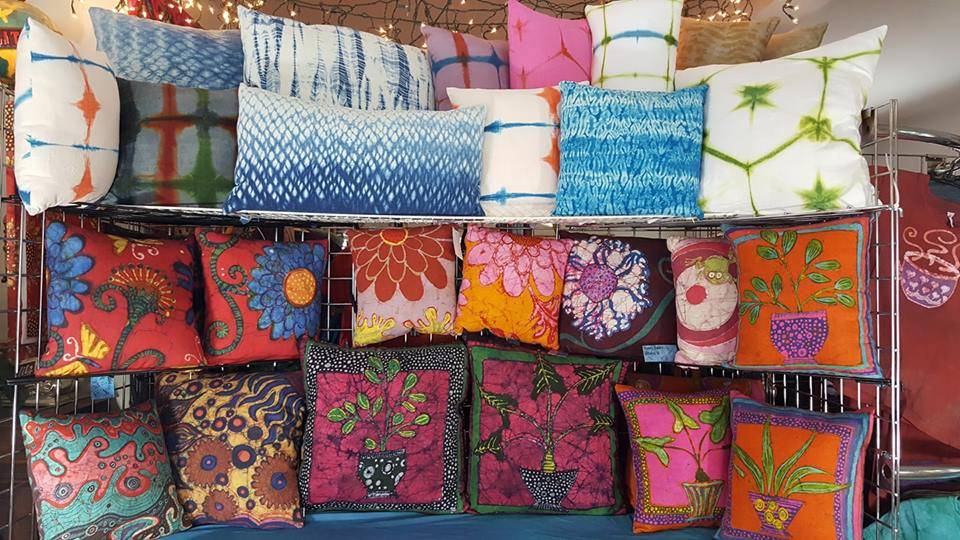Sewing soothes me. I enjoy working with simple objects like thread and needle, even though my skills are limited. My mother taught me how to reattach buttons, repair hems and holes, and make simple cloth bags when I was a child. I have great respect for people who can create useful everyday items like clothing, quilts, pillows, and bags. It’s even more impressive when they can make them look great!
The four women I talked to from Full Frontal Fiber all make beautiful things with simple objects. I spoke with Lisa Connery (Crass Stitching), Nora Love Miller (Frocks & Frippery), Jill Miller (Hooey Batiks), and Kelly McCleary (The Quirky Quiltress). I knew I’d like talking to them right away. Lisa Connery, for example, describes her work as “embroidery like Grandma used to make—if Grandma was drunk on whiskey…”
Smile Politely: How would you describe your process?
Lisa Connery (Crass Stitching): My process is pretty disorganized. I might go a few weeks only making something I already have patterns for, and then randomly start into new stuff. It’s pretty common for my boyfriend to come home to me, surrounded with supplies, laughing my ass off because I think whatever I’m working on is the funniest thing ever. He also smiles and nods when I shove a project in his face exclaiming, “Is that not the sexiest french knot you’ve ever seen?!” He understands my insanity. I usually have about 5 projects going at any given time: some embroidery, some cross stitch, pattern making, and, most recently, machine embroidery. Some things I see online and design my own versions of, some of my stitches are suggestions from my Facebook and Instagram followers, and some things are just me trying to see if I can make something from fabric and string or how to do different techniques. I like taking vintage designs and putting a modern spin on them or taking a dirty phrase and putting a traditional or feminine spin to the design to offset the profanity. That’s a long way of saying there is no real proces.
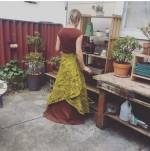 Nora Love Miller (Frocks & Frippery): I usually have a vague idea of what type of clothing I want to make, an idea of the style and era of inspiration, and what fabric I want to use. From there I let the process carry me to the end of the piece. I rarely plan a piece from beginning to end. I never use patterns and I am horrible at drawing, so I only make sketches if I need to be able to visualize the shape of a pattern piece. When working on a custom order, I listen to the client incorporating their ideas and desires, draw a bad rendition for them, and then let it flow. These are true to the original vision to insure the client is satisfied with their piece.
Nora Love Miller (Frocks & Frippery): I usually have a vague idea of what type of clothing I want to make, an idea of the style and era of inspiration, and what fabric I want to use. From there I let the process carry me to the end of the piece. I rarely plan a piece from beginning to end. I never use patterns and I am horrible at drawing, so I only make sketches if I need to be able to visualize the shape of a pattern piece. When working on a custom order, I listen to the client incorporating their ideas and desires, draw a bad rendition for them, and then let it flow. These are true to the original vision to insure the client is satisfied with their piece.
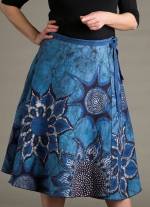 Jill Miller (Hooey Batiks): The batik process or the creative process? The easy one to answer is “What is the batik process?” Using melted wax, I paint a design onto fabric then
Jill Miller (Hooey Batiks): The batik process or the creative process? The easy one to answer is “What is the batik process?” Using melted wax, I paint a design onto fabric then
dip it in dye. Everything that’s wax-covered is protected from the dye. I use a special tool called a tjanting, that’s similar to a fountain pen, except it drips hot wax.
SP: How do you get inspired and then just…start!
Jill Miller: Design-wise, it’s everywhere! Color. Color combinations. My hobbies…gardening, chickens, food, cats, nature, seasons, Meadowbrook park. And then I’m also attracted to the absurd, ridiculous, and bizarre. [Getting] inspired to actually work is sometimes a challenge, but there are some projects that I dive into and get lost in them. And sometimes it’s not so much inspiration but it’s time to crank out the batiks because there’s an art show coming and bills to pay!
Kelly McCleary (The Quirky Quiltress): I am typically inspired by color combinations and/or visual patterns that I see all around me. I always have something that I’m already working on, but while I’m finishing one thing I’m already thinking about the next project. If I’m inspired enough, I can’t stop thinking about it until I actually execute the idea. Sometimes this involves stopping whatever I’m already doing to work on this new inspiration. Then I circle back around to the thing I was originally trying to finish, or I move on to the next inspiration. My process is really cyclical, and it’s inevitable that I am often sidetracked by new ideas, but the ideas themselves are completely random.
SP: How do you reconcile (or align) your artistic drive with your need or desire for monetary compensation?
McCleary: That’s an excellent question. First of all, I have no sense of shame with selling my work. Artists throughout history that we consider to be great very regularly sold their work, and they did this for a living. I do often have people openly question me about my prices, but only because they can go somewhere like Walmart or Target and buy an “ok” mass-produced quilt for maybe $50, which makes it hard for them to understand why one of my one-of-a-kind quilts are selling for $400. A lot of people also don’t understand all of the time, love, and materials it takes to make art. This is the biggest challenge that I have as an artist, and it’s actually something that a lot of us talk about pretty regularly. As long as you feel that the price you are charging covers your labor and materials fairly, that’s the best you can do. The absolute worst thing that I often see on sites such as Etsy, is artists underselling themselves in order to get sales. Doing this makes it harder for the rest of the art community to sell their work at reasonable prices, and it certainly doesn’t get the artist in question any kind of profit.
McCleary: This is why events such as Boneyard are wonderful for the community. People get the chance to connect with several different artists across all kinds of mediums to see what their process is, how much time and love it takes, and why each piece is so special.
Lisa Connery: Basically, Mama needs to eat. If I’m not at my full-time job, I am making things to sell, otherwise I’d be out working a part-time gig somewhere. And I actually do have a few other part time jobs that aren’t art related that I still do. I like my hobbies, but they aren’t cheap, and I don’t have enough wall space to hang up everything I make, so selling stuff is the only option to keep me off an all-ramen diet in a very well-decorated shack.
SP: For artists, and especially for women and other marginalized genders, it’s just sort of a given that we should do it for free or very cheap because we love it.
Connery: I generally don’t think much about gender and my art. I think when people assume my stuff should be cheap or free, it’s because they have no clue the time that goes into it, not that I’m a woman. I’ve combated that a bit by starting to sell kits. For the people who think my pieces are overpriced or that anyone can whip up something, I can now point them to a kit and tell them to have a ball. And if they still are grumbling, I can tell them to go kick rocks…or something a little more colorful. I will say that I am finding that praise for work that is traditionally a “woman’s craft” gets heaped on when it’s a man doing the craft. Like it is somehow more impressive that a man put needle to cloth or something.
Jill Miller: After doing art and fine craft shows and occasional street fairs for about 25 years now, I’ve developed a thick skin. I know how to respond to “Why is this so much, I could do this, I did this in high school” remarks. Only people running silent auctions for charity want me to give my art away. It was my dad–my small town, conservative, farming roots dad–who told me, in the very beginning, I needed to stop giving and start selling. As far as marginalization goes? If it’s happened to me, I haven’t noticed.
SP: What are your plans after the Boneyard Arts Festival? Any other projects coming up?
Nora Miller: I’m just going to keep letting pieces of fabric tell me what to make! We’re planning a major transition in our family, so I’m trying to figure out how I’m going to continue sewing daily without electricity.
Jill Miller: I usually do 1-2 art shows a month in Illinois and surrounding states so my plan is to keep pluggin’ away. My summer schedule is still developing; waiting
to hear from shows I’ve applied to. My calendar so far is on my homepage.
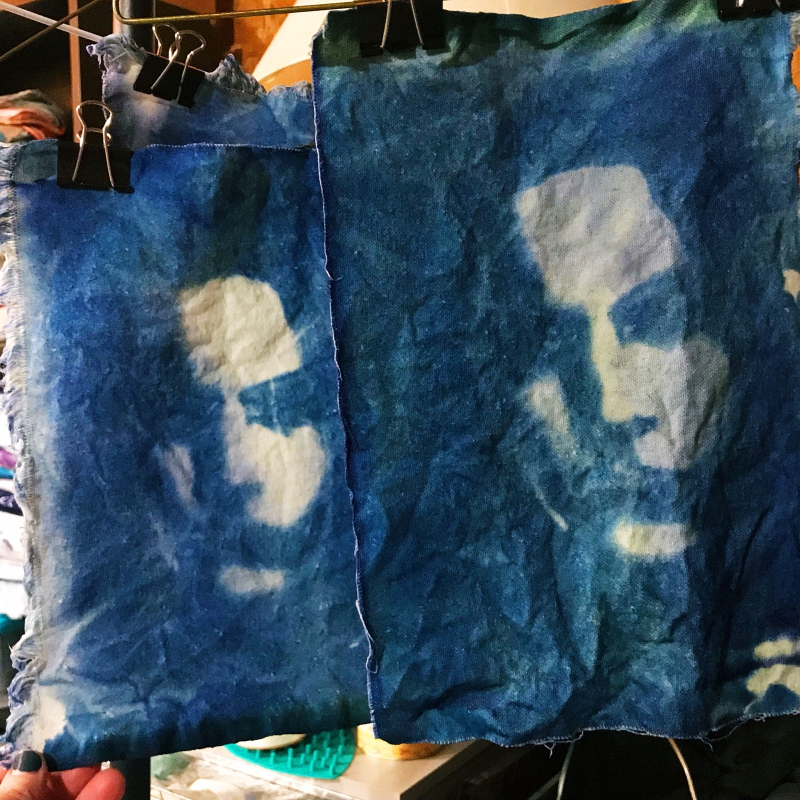
McCleary: Everything I’m working on right now is 100% Boneyard. I have a lot of hand dyed fabric that I’m going to be turning into throw size quilts. I will be selling them as part of a collection based on color–indigo, yellow, and gray—in various plays on traditional quilt blocks. I also already have several sets of funky quilted pot holders and hand-dyed zipper pouches available. Once Boneyard is over, I will assess my inventory and decide what I’d like to focus on next. One thing will be some experimentation with cyanotype, also called sun printing, which is an old-timey photography technique.
SP: How about you, Lisa? What’s after the festival for you?
Connery: I’m hoping to ramp back up my shows after Boneyard. My big goals for the year are to increase my work and have a good selection of pieces at all times, not just a frantic rush right before a show. I purchased an embroidery machine and have been playing with 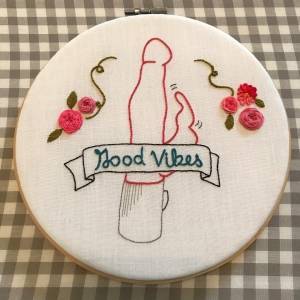 store-bought patterns, but the end game is creating my own designs for decor and clothing. I’ve been playing around with new mediums and techniques as well. I’m embroidering more and using paint and pencils to add to my work. It’s a little more freeing than strict cross stitch, and it has the potential to go very wrong, but it’s more exciting when it works out.
store-bought patterns, but the end game is creating my own designs for decor and clothing. I’ve been playing around with new mediums and techniques as well. I’m embroidering more and using paint and pencils to add to my work. It’s a little more freeing than strict cross stitch, and it has the potential to go very wrong, but it’s more exciting when it works out.
SP: I love this vibrator embroidery piece! I like the idea of combining “feminine” arts with crass or vulgar messages. It makes people laugh and, I hope, think about their misconceptions about what’s ladylike.
Connery: If the Rabbit or Hitachi Wand aren’t ladylike, I don’t know what is! I’ve also been working on a few more graphic/scandalous pieces, and I am loving them.
If you like textile art, I know you’ll find something at the Full Frontal Fiber’s show! Be sure to check them out and make a stop at some of the other showcases during the Boneyard Arts Festival!
__________________________________________________________________________
Full Frontal Fiber will be at Parasol Records April 13th and 14th. Click here for details.
Click here to find more venues and artists participating in Boneyard Arts Festival.
Top photo from Hooey Batiks Facebook page. Yellow skirt image by Nora Love Miller. Blue batik skirt image by Jill Miller. Sun printing image by Kelly McCleary. Embroidered vibrator image by Lisa Connery.








